
Borders mean little here — the Padma doesn’t think it’s worth even a pause. So the river flows on, even at Lalgola in West Bengal’s Murshidabad district, where it is part of the border between India and Bangladesh. The river refuses to pay heed to any man-made creations — border fences or security outposts — dismissing all such attempts with a casual change of direction every year during the monsoon. Over the last year, however, the Padma would have noticed a shift: the cattle smuggling trade between the two countries, much of it over the river and its tributaries, is now down to a trickle.
Officers of the Border Security Force (BSF), whose jawans patrol the 915 km stretch of the border that West Bengal shares with Bangladesh, estimate that cattle smuggling has come down by more than 70 per cent since the BJP-led government at the Centre made the issue one of its top priorities. In April last year, Union Home Minister Rajnath Singh instructed BSF personnel deployed along the border to check cattle smuggling.
Four months later, the minister touted the drop in figures for cattle smuggling as one of the government’s major successes: from about 20-22 lakh cattle that would be smuggled across the border every year, he said, the numbers had come down to 2-2.5 lakh cattle in 2015.
Since the NDA government came to power, the BSF has given its men discretionary powers to shoot at cattle smugglers, a strategy that has reportedly contributed to the drop in smuggling. In December 2015, in a written reply to a question in the Rajya Sabha, Minister of State for Home Kiren Rijiju had said, “During the current calendar year, 21 cross-border criminals were killed by the BSF along the Bangladesh border, of whom 16 were allegedly cattle smugglers.”
“We are taking different measures to ensure that cattle smuggling is stopped. Over the last year, we brought it to a halt and now we’ve asked the Centre to provide us with land to construct fences to stop all infiltration,” says BSF DIG R PS Jaswal.
BSF officers claim their efforts have had a direct result on sale of beef in Bangladesh. Figures available with the cattle haat (market) in Bangladesh show that around 22 lakh cattleheads were sold in 2013, 18 lakh in 2014, but only 4.5 lakh in 2015.
But what Delhi sees as ‘smuggling’, Dhaka sees as legitimate cross-border trade. So during the November 16-17 Home Secretary-level talks between the two countries, Bangladesh raised the issue of rising prices of beef in that country as a result of the BSF crackdown. Dhaka reportedly also requested Delhi to “go easy” on cattle smugglers.
The BSF has identified 64 Border Outposts (BOPs) along the Bengal-Bangladesh border that are vulnerable to cattle smuggling. Of these, they say, 46 account for 80 per cent of the cattle smuggling cases. Eight of these are in Murshidabad, where the river makes the border particularly hard to sanitise.
The BSF’s outposts are mostly bamboo sheds where jawans spend the nights. In the mornings, these outposts see a steady stream of people who take their cattle to the other side to graze. The jawans greet the cattle herders, reminding them to be back before sundown.
Besides the outposts, new fences have been set up and BSF jawans patrol the river, their twin-engine speed boats rushing past the smaller country boats.
But everyday life has a way of looking beyond the jawans, their guns and their speedboats. Umaruddin Ahmed, a farmer in Aurangabad village, says he routinely crosses over with his herd of cattle. “Why should the border matter? My sister lives in Bangladesh. My ties with her are more important than anything else. We have documents issued by the state government that prove we live in India. The BSF examines our papers and allows us to walk across,” says Ahmed, who has just returned from another visit to his sister. While the younger of his three sons takes care of his 200 sq ft field, he takes care of his cattle, taking them for walks across the border. “My cattle like grazing on the other side. Here there are too many cows and not enough space. And of course, I get to chat with my sister,” he says.
This easy relationship that the villagers share with the border coupled with the Centre’s push to stop cattle smuggling leave the BSF with an unenviable job. Not only do they have to ensure that every Indian citizen who crosses the boundary is properly identified and returns before sunset, they also have to photograph, tag and count every animal that crosses the border.
“If someone returns with one animal less, we immediately file a case against him and hand him over to the police. There is no separate section in the Indian Penal Code for cattle smuggling, so we register cases under sections pertaining to cheating,” says a senior officer of the BSF’s Lalgola unit who spoke on condition of anonymity.
The daily ritual of counting cows at checkposts, once in the morning and then again in the evening, is one of the many ways the BSF hopes to counter a trade that has thrived in the area for as long as anyone can remember.
Apart from constructing border roads, putting up flood lights and increasing outposts along the border, the BSF has also increased the frequency of its surveillance. On Thursday, the Union Home Minister said a plan had been finalised to complete the fencing of the border.
The BSF is now digging trenches and laying iron pipes in them along the barbed wire fences at the border. “The trenches and the pipes will make it difficult for the cattle to jump across. This method has been very successful,” says IG Sandeep Sulanke, who is in charge of the BSF’s South Bengal Frontier.
On more than one occasion, however, BSF jawans and officers have found themselves outnumbered and outflanked by the cattle smugglers. “In December, we ambushed a big group of smugglers and their cattle. When we fired in the air, the cows, around 200 of them, started running helter-skelter and the smugglers gave us the slip. We were left holding the tails of a few cows. We only managed to round up about 50 cows,” says a BSF officer posted at Cooch Behar, the district neighbouring Murshidabad, where the BSF claims cattle smuggling has come down — from a lakh a day to 500 — since the land boundary agreement on enclaves made it easier to identify the border.
Despite their efforts, many in the BSF feel that given the socio-economic realities of southern Bengal, the demand for beef and the nearly limitless supply of ageing bovines in India, smugglers will soon find a way to hoodwink them.
“We are doing our best and the situation (of cattle smuggling) is far better now than before, but frankly, we can stop, say, 10 cows. How can we stop a hundred? There’s a constant supply of cows from India and high demand in Bangladesh. With the kind of poverty in these parts and the money that’s to be got from smuggling, to many of them, the risk of getting arrested or even dying during a smuggling operation seems worth taking,” says a BSF officer who is posted at the BSF’s Murshidabad circle headquarters in Behrampore town.
In June 2015, the BSF had in its official magazine suggested that the only way to curb cattle smuggling was to “legalise the export of over-aged and non-milching animals” and “promote beef industry in India” by allowing the slaughter of unwanted cattle.
It’s a little before noon and a cattle haat is on at Omarpur, a little over 8 km from Lalgola at the border. The haat, one of the larger cattle haats of Murshidabad district, comes alive every Sunday. Several thousand cows are brought here for sale from across India — particularly Haryana, Rajasthan, Uttar Pradesh, Bihar and Jharkhand. Most of the cows are old and sick, their ribs sticking out, their eyes glazed.
“Almost all these cows will be smuggled across the border for slaughter, some will make it to the few legal slaughterhouses in the state,” says a trader.
“I have just sold two of my cows for Rs 13,000. They were healthy and fetched a good price. I am going to buy some chicken and vegetables and we’ll have a feast at home today. It’s a Sunday after all,” says Ibrahim Kazi from Behrampore town, briskly counting the notes.
For decades, the smuggling and sale of cattle across the border have provided sustenance to families in Murshidabad, both Hindus and Muslims. The trade has thrived, often as a family profession, with secrets passed down generations: how to evade the BSF, the best routes to transport cattle, how to ensure stealth while crossing the border.
The economics of cattle smuggling is what makes the BSF’s job tough. For most Indian farmers, a cow past its prime is of little value. Besides, tractors have long replaced bulls and oxen and they are of little use too. So the cattle are sold to traders who supply them to slaughterhouses in India, both legal and illegal. But with beef selling for around Rs 350-Rs 450 a kg in Bangladesh, in comparison to Rs 150 a kg in Bengal, smuggling is far more lucrative.
Villages such as Shamsherganj and Lal Kola are seen as the hub of the cattle trade. By day, however, these are just an idyllic expanse of green. Their fields, thick with silt from the Padma, are among the most fertile in the country. But fragmented landholdings have forced villagers to look for livelihood options elsewhere — and it’s cattle smuggling that most turn to.
“We grow vegetables and our produce is possibly the best in the state. But we don’t earn any profit. The money we earn, which allows us to educate our children, comes from taking cattle to Bangladesh,” says Barun Mondal, a farmer at Shamsherganj.
However, he claims to have stopped himself. “I used to transport cattle from the haats to the collection point. It wasn’t thought of as illegal until recently.”
Ahmed Raza, the headman at Chotokalia hamlet in Shamsherganj, says, “Most families here survive because of cattle smuggling. Women roll beedis at home and men tend to their farms. But without the cattle trade, our income will go down by half. There are already families here who can no longer afford to send their children to school. Education is free, but they’d rather have more hands to work on the fields if that’s the only source of income,” he says.
Ranjit, a villager from Omarpur in Murshidabad, who now works for an insurance company, says he smuggled cattle for most of his adult life. “You can’t do this on your own. You need to be part of a network,” says the 42-year-old, adding smugglers usually organise themselves along religious or caste lines. “For instance, the Muslim families of Omarpur look out for each other. Similarly, smugglers of the Ghosh community share information with each other,” he says.
Though he now sells insurance to people in his village, “I was very good at smuggling,” he says proudly. That makes him qualified to explain the trade and its ways.
To begin with, he says, villagers bring their cows to the haats, from where ‘transporters’ take them to collection points. “The transporters avoid the main roads and usually move with not more than two cows at a time. Depending on the distance they cover, they get paid Rs 200-Rs 500 to take the cattle to the collection point,” he says.
This collection point is usually the home of a villager who is trusted by those in charge of the operation. “Here the cows are kept for a few days until there are at least a hundred cows in one village. The smuggler pays for the upkeep of the cows and also pays a few thousands to the person whose house is the collection point,” says Ranjit.
The third and final part of the operation is the actual crossing of the border. This is done by cattle herders, usually young boys called rakhaals. The cows are fed a mixture of mustard oil and salt, which, smugglers believe, makes them less likely to moo while crossing. At places where the river separates the two countries, the cows are led into the water and forced to cross the river. “The rakhaals hold on to the cows’ tail as they swim across the river to the other side. Smugglers prefer taking at least a hundred cows together because even if the BSF were to interrupt the smuggling operation, there is no way two patrolling officers can stop a hundred charging cows or bulls,” he says.
“The rakhaals choose their time and moment to cross over — they usually do so when there’s heavy fog or when it’s raining. That makes it very difficult for us to see the cows as they move across the border,” says a BSF jawan posted at the Murshidabad circle headquarters.
The BSF has been filing FIRs against the cattle smugglers they arrest before handing them over to the police. But the police, they say, need to do more. “The BSF is limited to the border, but the police can make arrests in the haats. But that doesn’t happen, making our job almost impossible,” says the officer.
So for now, the BSF relies on its meticulous headcount. “There is a joke in the BSF now about how we are actually the CSF or the Cattle Security Force. We are following our orders and we are stopping the smuggling of cattle. But as far as national security is concerned, many of us feel that our efforts will be better directed at stopping the flow of fake currency and contraband and not counting cows,” says a senior BSF officer.
Source : Indian Express

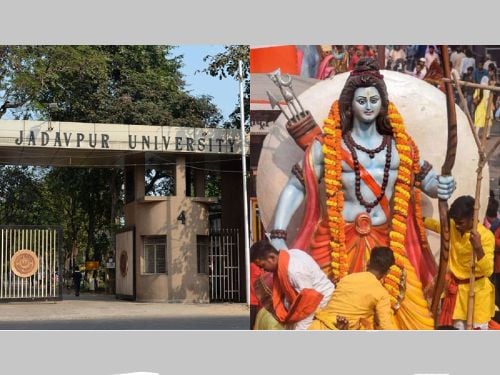 Jadavpur Univ revokes permission to celebrate Ram Navami on campus after granting it
Jadavpur Univ revokes permission to celebrate Ram Navami on campus after granting it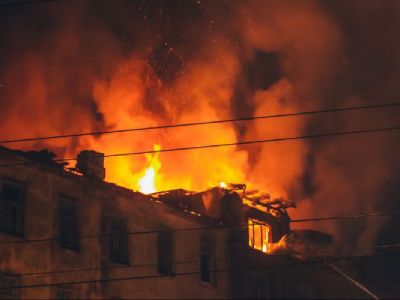 Andhra Pradesh: Farooq kills mentally challenged Hindu man for insurance money
Andhra Pradesh: Farooq kills mentally challenged Hindu man for insurance money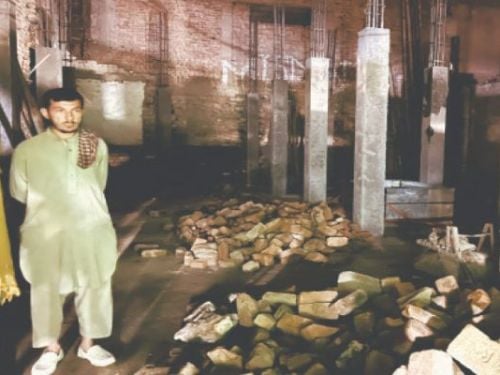 Pakistan: Ancient Hindu temple in Khyber Pakhtunkhwa demolished for commercial complex
Pakistan: Ancient Hindu temple in Khyber Pakhtunkhwa demolished for commercial complex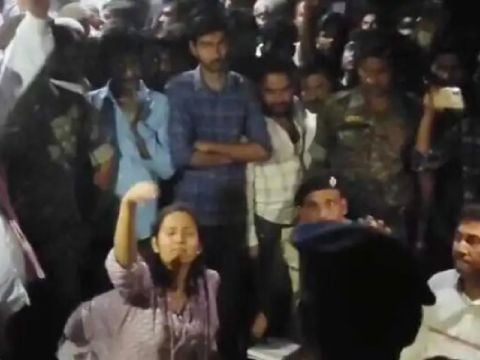 Bihar: Goddess Bhagavati Temple in Araria vandalised and deities damaged
Bihar: Goddess Bhagavati Temple in Araria vandalised and deities damaged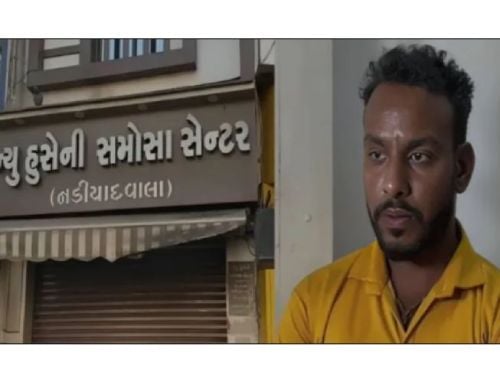 Vadodara: Beef supplier Imran Qureshi arrested in beef-stuffed samosa case
Vadodara: Beef supplier Imran Qureshi arrested in beef-stuffed samosa case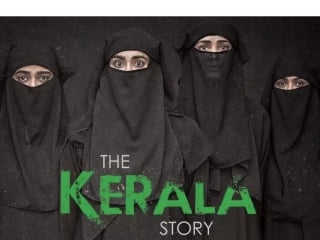 After Idukki diocese, Syro Malabar Catholic Church’s Thamarassery diocese screens ‘The Kerala Story’
After Idukki diocese, Syro Malabar Catholic Church’s Thamarassery diocese screens ‘The Kerala Story’